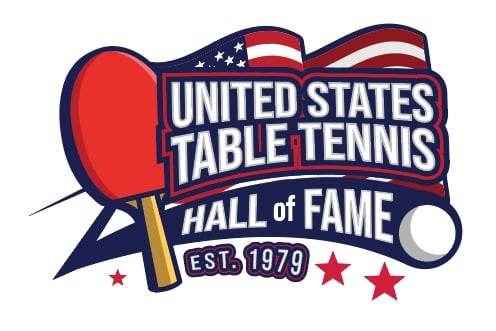Coutesy of Tim Boggan
Originally, William V. Schnur’s Becker Company started out in the luggage manufacturing business, but the hard times of the ending 1920’s and early ’30’s increasingly turned him to table tennis.
And for a time his daughter too. Gertrude (“Trudie” or “Trude”) Schnur, played in the first (1933) American Ping-Pong Association (APPA) National’s open to women, and came close to winning it, losing in the semi’s, in 5, to the eventual winner Jessie “Jay” Purves.
That Nov., at the Hotel Sherman in Chicago, the first American Zone Tournament was held that would determine who would represent the U.S. at the Dec., ’33 Paris World’s. The Men’s and Women’s Singles winners and the Men’s Doubles winners would be automatically eligible, but only the Men’s Singles winner’s way would be paid. (Nineteen-year-old Lower East Side New Yorker Marcus Schussheim triumphed and went to Paris as our lone entry.) The 16-entry Women’s was won by Miss Schnur over Alice Curtis who’d beaten the ’33 Chicago Northshore titleholder Carol Herr. Madeline Hemingway, sister of famed novelist Ernest Hemingway whose telegram “Go in and win” helped her to become the 1934 Chicago West Suburban Champion, didn’t enter.
Trudie was a 16-year-old “honor student at New Trier High School” in Winnetka, Illinois, the same school Billy Condy, also 16 and in a few months the 1934 APPA National Men’s Singles runner-up, attended. Perhaps not coincidentally their successes had been encouraged by New Trier Athletic Director W. L. Childs who’d already installed “twenty tables for the students” and hoped eventually “to have a hundred.”
Trudie’s win (which she would soon follow with victories in the Illinois State over Mildred Wilkinson and the Western over Virginia Booth) was poetically appropriate, for as USTTA President Carl Zeisberg would later point out, Trudie’s father, Will, “went far beyond what a manufacturer would do for the game.” He “financed” this first American Zone Tournament, “which really put the infant USTTA on its feet.” And yet (perhaps because she was only 16 and would need a chaperone?) he would not finance his daughter’s trip (and doubtless the chaperone’s) for the once-in-a-lifetime experience of playing in the World Championships?
A year later, from Dec. 28, 1934 through Jan. 24, 1935, U.S. Table Tennis was treated to the famous Coleman Clark “Circus”–featuring the great World Champion Victor Barna and his former World Champion Doubles partner Sandor Glancz. This was a barnstorming Tour of 20 U.S. cities, promoted by “Cokey” Clark. Zeisberg again singled out for praise Will Schnur’s generosity. “Declining to participate in any possible profits [from the Tour] he quietly guaranteed to pay any deficit that might result.” Fortunately the “Circus” was a great success. And no doubt Clark, who’d pushed for it, and Schnur, who’d been so cooperative, already had the good vibes that would soon allow them to form a business relationship. Clark, after all, had a “name”–he was the 1932 APPA Champion, and a power in Chicago table tennis.
In 1935 the Becker #21 Birch Top table, the Sta-Rite #7 net, and the Sametz Mercury ball, which Becker was the momentary Western representative for, were selected for the Chicago National’s. Though thereafter only the 1936 Philadelphia National’s used a Becker table–the #1 Hard-Base–the Company’s nets were used for all U.S. Opens up through 1940. Also, from the mid-’30s into the last pre-War one in ’41 (no Intercities were held from ’42 through ’45), Becker tables were used for the three Intercities held in Chicago. Later came the Becker Wembley ball.
The Becker manufacturing cause was helped, particularly in the Midwest, when in the mid-’30’s Schnur, who lived in the Chicago suburb of Glencoe, hired Clark, the most popular exhibition player of his time, to do promotional work for the company. Cokey would entertain with various partners at such glamorous places as the Coconut Grove in Los Angeles, the Latin Quarter in Boston, the Roosevelt Hotel in New Orleans, and the Last Frontier in Las Vegas.
Becker promoted a Coleman Clark racket for $1.75, and with that you also got Clark’s booklet “How to Play Table Tennis.” A six-pack of Coleman Clark balls was perhaps an even better seller. As a Becker Topics’ ad chart would proclaim, the Clark ball lasted longer than any other without cracking.
Rubber? Perhaps Becker is best known for having brought to the U.S. the famous English Leyland rubber, which was used by every top player in the world. But of course there wouldn’t be much rubber for table tennis during the War. By the time World War II ended, and table tennis rubber was again available, Schnur was almost 65 and P. Becker and Company almost History.
But Schnur in his old age was remembered. In 1961, USTTA Executive Secretary Jimmy McClure presented an Honorary Life Membership to him, primarily for his many contributions to the fledgling Association. Will Schnur died Feb. 18, 1966 at the age of 85.
